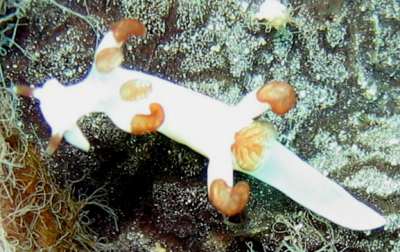
Trapania sp. 9
Order: NUDIBRANCHIA
Suborder: DORIDINA
Superfamily: ANADORIDOIDEA
Family: Goniodorididae
PHOTO
Pulau Lang, 7m, West Malaysia, South China Sea, 2 October 2005, Sandy with staghorn corals and algae. Length: 10mm. Photographer: Alvin Ho.
Similar to T. darvelli See discussion in message #16182.
Authorship detailsRudman, W.B., 2006 (April 12) Trapania sp. 9 [In] Sea Slug Forum. Australian Museum, Sydney. Available from http://www.seaslugforum.net/find/trapsp9
Related messages
Trapania darvelli? from East Timor
March 17, 2008
From: Brian Francisco
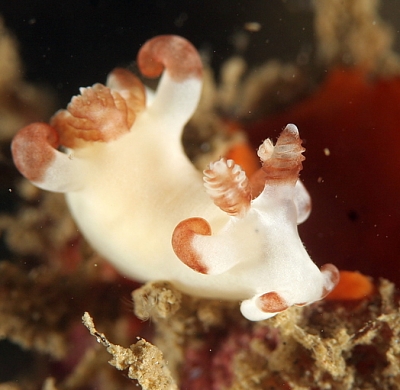
Concerning message #21435:
Hi Bill
Good timing for the Trapania postings. We just encountered a Trapania darvelli last week nibbling (possibly) on an orange sponge.
Locality: Tasi Tolu, 18 meters, East Timor, Banda Sea, 9 March 2008, sandy slope. Length: 10 mm. Photographer: Brian Francisco.
Glad to have you back.
Brian
UnderWater East Timor
francisco.brian@gmail.com
Francisco, B., 2008 (Mar 17) Trapania darvelli? from East Timor. [Message in] Sea Slug Forum. Australian Museum, Sydney. Available from http://www.seaslugforum.net/find/21452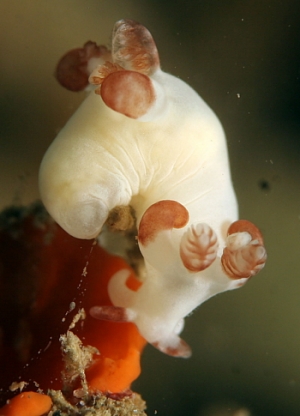
Dear Brian,
You may be right in identfiying these animals as T. darvellie but I have been keeping them separate as Trapania sp. 9 because of the orange rather than brown colouration, because the lateral processes are usually held out rather horizontally and because the cloured tips of the processes seem to be 'knobbly' perhaps glandular [see discussion in message #16182.] Your seem to be almost an intermediate.
Concerning their food. If you do a search for entoproct or Kamptozoa on the Forum you will find a whole list of messages reporting, or showing that entoprocts are the preferred food of species of Trapania. Species of Trapania are often found on sponges and we used to think they fed on sponges - although nothing in their radular tooth structure or the food of their close relations would would suggest sponges were a likely food. Have a look at the Fact Sheet for Kamptozoa [= ectoproct] for some background information. Some species are usually found living on sponges - hence the confusion.
Best wishes,
Bill Rudman
Does Trapania sp. 9 = Trapania darvelli
March 28, 2006
From: Vie Panyarachun
Re message #16145
Hi Bill,
Trapania sp. 9 seems very similar to Trapania darvelli - are they the same?
Vie
vpanyarachun@hotmail.com
Panyarachun, V., 2006 (Mar 28) Does Trapania sp. 9 = Trapania darvelli. [Message in] Sea Slug Forum. Australian Museum, Sydney. Available from http://www.seaslugforum.net/find/16182Dear Vie,
Identifying animals from photos is a bit like writing with your writing arm tied behind your back. In this case it would be very valuable to know what the radular teeth looked like. One problem is we only know Trapania darvelli from a few records so I am not sure whether this orange brown colour is part of the colour variation of that species or even if it is because of an over exposed photo. What struck me as different were the glandular looking lumps on the tips of the latero-dorsal processes and how much longer the processes seem to be. I could be wrong so any more records of these animals would be welcome.
Best wishes,
Bill Rudman
Trapania sp 9
March 27, 2006
From: Ho Wei Kwok Alvin
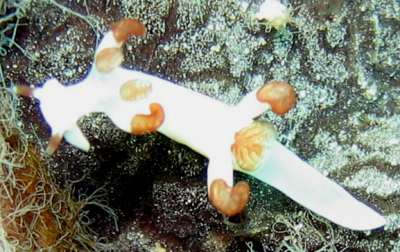
Hi Bill,
wonder if you could ID this teeny nudi for me? Think it's a juvenile Trapania? Took this last yr at a site called secret garden at Pulau Lang, off Pulau Aur/Dayang in West Malaysia. The picture is a bit blur because it's so tiny!
Locality: Pulau Lang, 7m, West Malaysia, South China Sea, 2 October 2005, Sandy with staghorn corals and algae. Length: 10mm. Photographer: Alvin Ho.
Many thanks,
Alvin
howeikwok@hotmail.com
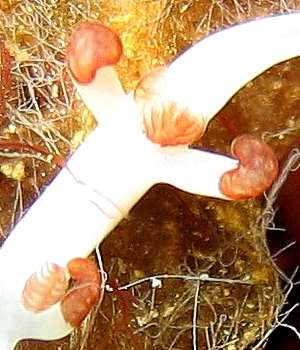
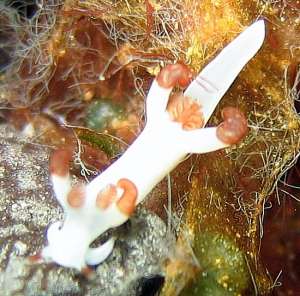
Dear Alvin,
Yes this is a species of Trapania, but unless my memory is failing me it hasn't got a name. I'll call it Trapania sp. 9. The latero-dorsal processes are rather interesting. The brownish tips seem to contain spherules - perhaps glands?
Best wishes,
Bill Rudman
